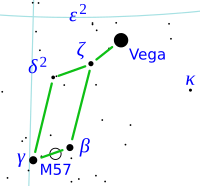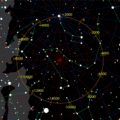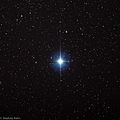Vega facts for kids

Vega is a very bright star in the sky. You can find it in the constellation called Lyra. It's the brightest star in Lyra! Vega is also the fifth brightest star we can see at night. In the northern part of the sky, it's the second brightest star, right after Arcturus.
Vega is quite close to Earth, only about 25 light-years away. A light-year is how far light travels in one year. That's a huge distance! Because it's so close, Vega looks very bright to us. It's one of the brightest stars near our Sun.
Astronomers have studied Vega a lot. Some even say it's the most important star to study after our Sun!
Contents
Vega's Amazing History
Vega has a cool history. Around 12,000 BC, Vega was our North Star. This means it was the star that the Earth's North Pole pointed towards. It will be the North Star again in about the year 13,727. This happens because of a slow wobble in Earth's spin, like a spinning top.
Vega was the first star, besides our Sun, to be photographed. It was also the first star to have its light broken down into a spectrum. This helps scientists learn what stars are made of. Vega was also one of the first stars whose distance was measured using a method called parallax.
Scientists have used Vega as a standard to measure how bright other stars are. It helps them set the scale for star brightness.
Vega Compared to Our Sun
Vega is much younger than our Sun. It's only about one-tenth the Sun's age. But Vega is also much bigger! It has about 2.1 times more mass than the Sun. Because it's so much bigger, it uses up its fuel faster. So, Vega is expected to live for about one-tenth as long as the Sun.
Both Vega and the Sun are currently in the middle of their lives. Vega does not have many heavy elements, like iron or gold. It's mostly made of lighter elements, like helium.
How Vega Spins
Scientists think Vega might be a variable star. This means its brightness might change a little bit over time.
Vega spins very, very fast! It spins at about 274 kilometers per second at its middle. Because it spins so quickly, its middle bulges out. This is like when you spin a ball of dough, and it gets wider in the middle. This fast spin also means that Vega is hotter at its poles (the top and bottom) and cooler around its middle. From Earth, we are looking at Vega from the direction of one of its poles.
Dust and Planets Around Vega
Scientists have found extra infrared light coming from Vega. This suggests that Vega has a disk of dust around it. This dust probably comes from objects crashing into each other in a ring of space debris. It's similar to the Kuiper belt in our own Solar System, which is a region beyond Neptune with many small icy bodies.
Stars that show this extra infrared light from dust are sometimes called "Vega-like stars." Scientists also think that there might be at least one planet orbiting Vega. This planet is likely to be about the size of Jupiter.
Images for kids
-
Artist's concept of a recent massive collision of dwarf planet-sized objects that may have contributed to the dust ring around Vega
See also
 In Spanish: Vega (estrella) para niños
In Spanish: Vega (estrella) para niños








